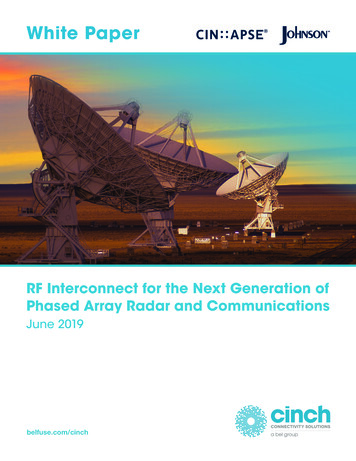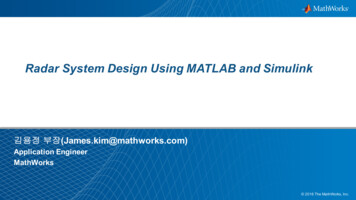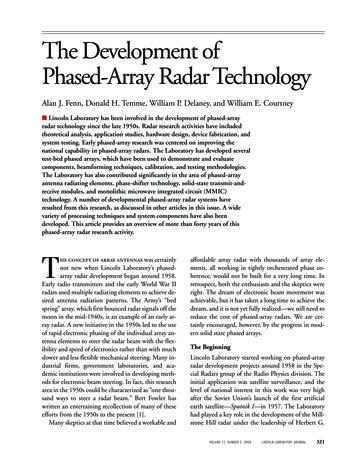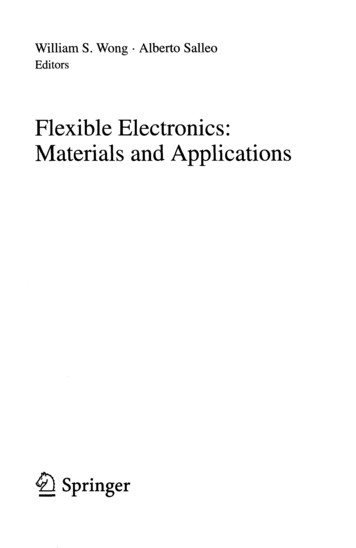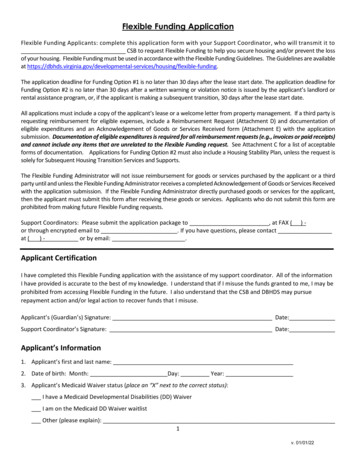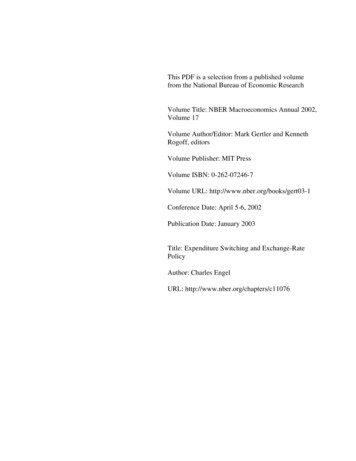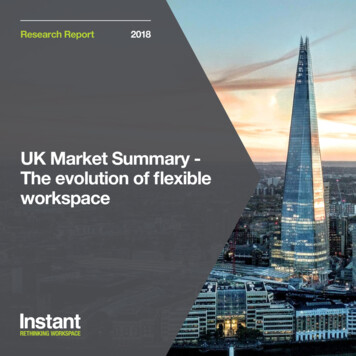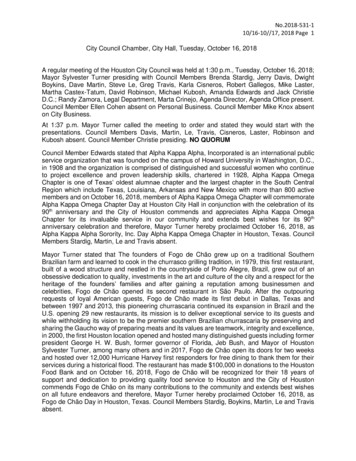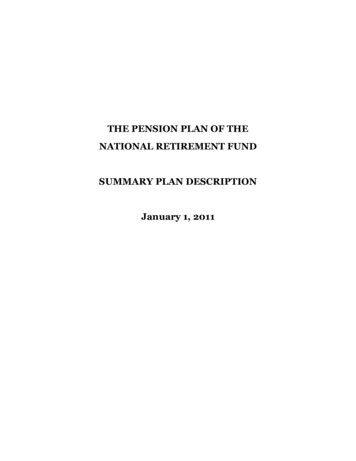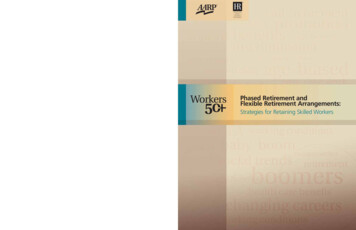
Transcription
The Society for Human Resource Management(SHRM) is the world’s largest association devotedto human resource management. Representingmore than 200,000 individual members, theSociety’s mission is both to serve human resourcemanagement professionals and to advance theprofession. Founded in 1948, SHRM currently hasmore than 550 affiliated chapters and members inmore than 100 countries. Visit SHRM Online atwww.shrm.org.AARP and SHRM recognize that future success depends on uniting strategic business needs withworkplace practices that maximize the experience of mature workers. AARP and SHRM collaborateon strategies to create business solutions to address an aging workforce.Phased Retirement andFlexible Retirement Arrangements:Strategies for Retaining Skilled WorkersAARP is a nonprofit, nonpartisan membershiporganization that helps people 50 have independence, choice and control in ways that are beneficialand affordable to them and society as a whole. Weproduce AARP The Magazine, published bimonthly;AARP Bulletin, our monthly newspaper; AARPSegunda Juventud, our bimonthly magazine inSpanish and English; NRTA Live & Learn, our quarterly newsletter for 50 educators; and our website,AARP.org. AARP Foundation is an affiliated charitythat provides security, protection, and empowerment to older persons in need with support fromthousands of volunteers, donors, and sponsors. Wehave staffed offices in all 50 states, the District ofColumbia, Puerto Rico, and the U.S. Virgin Islands.D18508 (306) 2006 AARPAll rights reserved. Reprinting with permission only.601 E Street, NW, Washington DC 20049www.aarp.org/employerresourcecenter
Phased Retirement andFlexible Retirement Arrangements:Strategies for Retaining Skilled WorkersContents2Introduction: The Twenty-First CenturyWorkplace—Managing the Human Capitalof Workers 50 3Phased Retirement: A Strategy forRetaining Skills and Knowledge4Factors Influencing the Business Need forPhased Retirement6Creating a Phased Retirement Program10 Marketing a Phased Retirement Programto Your Employees12 Challenges to Implementing PhasedRetirement and Proposed RegulatorySolutions13 Ahead of the Curve: Cutting EdgeEmployee Programs14 Conclusion15 Appendix A: Phased RetirementConsiderations16 Appendix B: Phased Retirement Resources17 Appendix C: Profiles of Phased Retirement21 Endnotes1
Introduction:The Twenty-First Century Workplace—Managing the Human Capital of Workers 50 The American workforce is aging and this trend will reshape theU.S. labor force over the next decade and beyond.As the baby boomer population retires, a dip inthe number of younger workers means theremay be more jobs than qualified workers to fillthem. Some employers are already experiencing a shortage of qualified workers. Theprojected labor and skills shortages posepressing questions for employers. What cancompanies do to remain competitive in today’smarketplace? Are there practices and policiesthat will appeal to workers 50 , whose skillsand experience make them a valuable workplace commodity?Implementing appealing work arrangementsthat attract and retain workers 50 maybecome increasingly important in anorganization’s bid to survive in today’smarketplace. Phased retirement, which allowsthe employee to reduce work time in his or hercurrent job, is regarded as one strategy toencourage hard-to-replace, experiencedworkers to postpone leaving the labor force.2In 2002, 14 percent (or20.8 million) of theworkforce was 55 andolder according to theU.S. Bureau of LaborStatistics. This figure isexpected to increase to19 percent (just morethan 31 million) by2012.1 The aging of theworkforce has enormousimplications for ournation’s employers.2
Phased Retirement: A Strategyfor Retaining Skills and KnowledgeWhat is Phased Retirement?Phased retirement has no succinct definition.The term phased retirement often refers to abroad range of flexible retirement arrangements, both informal practices and formalworkplace policies, which allow employeesapproaching normal retirement age to reducethe hours worked or work for their employersin a different capacity after retirement.The reduction in work hours has severallegal and compensation implications thatpresent a barrier for some employers who wishto develop programs to retain their workforce.To address this ambiguity and clarify phasedretirement programs, the Internal RevenueService (IRS) is considering proposedregulations that will establish criteria andguidelines for creating and administering aphased retirement program.Currently, informal phased retirementarrangements are more commonplace thanformal programs. When employers do have aformal written policy in place, it is oftenflexible and tailored to individual cases.3What is the differencebetween informalpractices and formalflexible retirementarrangements?Some primary characteristicsthat may distinguish formalflexible retirement arrangements from informal onesinclude: A management structurefrom which one has to getformal approval; Clear eligibility criteria; Written materials that aremade available to employeesat orientation andincorporated into discussionsabout benefits; and Continued access toemployer-sponsored benefits.3
Factors Influencing the Business Needfor Phased RetirementAlthough IRS guidelines for creating a phased retirementprogram have not been established, some employers are instituting innovative policies and practices as part of a deliberatestrategy to keep skilled workers from exiting the labor force. Employees are working beyond traditionalretirement age; research suggests that“abrupt” retirement will evolve into a moregradual or staggered process.Cinergy, an energy company in Cincinnati,Ohio, will face workforce challenges in the nextfive to seven years as 50 percent of Cinergy’semployees become eligible for retirement. Tonavigate the demographic challenges posed bya possible shortage of skilled workers, Cinergyhas positioned workplace programs to allowtheir employees to reduce their work hours inan effort to retain their workforce. Retaining askilled workforce through periods in whichsharp spikes in employee turnover have beenprojected requires thinking differently aboutwork and how work can be accomplished.To a large extent, the appeal of such flexibleretirement arrangements is shaped by thefollowing factors, which are exerting influenceon the landscape of the U.S. labor force: Changes in Social Security have made iteasier for recipients to continue workingafter reaching full retirement age withoutlosing their benefits. Americans are living longer, which meansthat retirees will need greater financialresources to support themselves.Some of the benefits of implementing flexibleretirement arrangements position an employerto:4 Maintain continuity of essential businessoperations by retaining key workers whosepositions may be difficult to fill; Organizations are seeking ways to retainexperienced workers, especially those whohold critical positions that may be difficultto replace. Enhance productivity by addressing theneed for work/life balance; Reduce costs associated with hiring andtraining new employees;4
Increase organizational flexibility by tappingretirees as consultants or contractors; and Forecast future workforce needs andemployee benefit costs.Workers 50 can also benefit from flexibleretirement arrangements. Advantages caninclude: Flexible work arrangements that allow themto juggle competing non-workresponsibilities (e.g., providing care to afamily member); Opportunity to transition into retirementrather than make an abrupt exit from theworkplace; Ability to stay connected to the organizationand contribute to its continued success; Increased income for those whoseretirement funds are insufficient; Opportunity to maintain continued accessto employer-sponsored health care andwelfare benefits; and Continued professional development.Careful planning can make the workplacemore attractive, help businesses make themost of the projected demographic realities,and capitalize on the skill sets and experiencesof workers 50 .5
Creating a Phased Retirement ProgramWhen confronted with the need to retainskilled workers, employers have often implemented ad hoc arrangements targeted tospecific employees with particular skills.Although this informal approach may help insome situations, such practices may be inadequate for addressing the long-term needs oftoday’s organizations.Instituting an effective phased retirementprogram compliant with applicable federal andstate laws will require careful planning. Howcan employers determine whether a phasedretirement program is warranted? And once thecase for a more formal plan is established,what steps can employers take to meet theneeds of workers while complementing theorganization’s business goals? Key questions toask when considering a phased retirementprogram may include the following:just becoming aware of the issue5, according toresearch conducted by the Society for HumanResource Management (SHRM).To effectively plan for future labor needs,businesses should have reliable informationon their workforce demographics and be ableto assess potential skills shortages associatedwith changes to their workforce composition.Taking this first step of building a long-termbusiness strategy is one tactic advised bymany experts. This planning should focus oncollecting demographic data and projectedretirement trends, as well as the necessaryfuture education and skills required for theorganization’s workforce.6Are You Facing a Skill Shortage?Once the business case for a phased retirementprogram is established, an inventory of coreskills necessary for a long-term strategichuman resource plan will be needed.7Assessing skills throughout the workplace overa five- to ten-year period can assist organizations in identifying specific skill sets thatrequire heightened attention.Data capturing the immediacy of workplacedemographics, including the demand andsupply for critical skills and employees, shouldbe considered in conjunction with otherAre You Facing a Labor Shortage?Recent data indicates that a majority ofemployers have not considered whether theirorganization is at risk of experiencing a laborshortage. When asked to describe their organization’s preparedness for a labor shortage, 39percent of human resource professionals werejust beginning to assess internal policies andmanagement practices, and 38 percent were6
workforce metrics to assess the valueproposition of “retaining retirement eligibleworkers versus recruiting, training, andretaining new employees.”8 If the talentassessment reveals that older workers withdifficult-to-replace knowledge and skills willbe leaving the organization, a phasedretirement program, as well as a clearsuccession plan, can be designed andimplemented.”9Mercy Health System inJanesville, Wisconsin,offers a variety of workschedules and has theflexibility to create jobsImportant considerations during the designstage include: Which employees should be offered phasedretirement arrangements;that are both employer The age at which employees become eligibleto participate in the program;The Work to Retirementand employee friendly.program was formalized How critical knowledge will be transferred toother workers; and perhaps most important,in 2005 and involves more Identifying legal and compensationimplications.than 100 employees. TheOrganizational Buy-Inprogram helps MercyHealth System retain theirIdentifying a core group to support and workwith the human resource professional isimportant to ensure that the phased retirementprogram is successfully implemented. A coregroup of professionals might include theorganization’s benefits and legal counsel.Having the support of the CEO and other topmanagement is most critical to the success ofthe program as is ongoing employee participation once the program is implemented.pool of skilled nurses byproviding employees witha seasonal work option,flexible scheduling, awork-at-home option, andschedule reduction.7
Stanley Consultants, Inc.Identifying and Integrating PhasedRetirement Program Componentsin Muscatine, Iowa,An organization’s corporate culture and priorexperience with flexible retirement arrangements can serve as a compass for creating aphased retirement program that appeals toworkers 50 . Examples of alternative workarrangements used by organizations that cansupport or foster the establishment of a phasedretirement program include: 10implemented atelephone campaign toretirees whenadditional experiencedstaff was needed for a Job sharing;large electrical Telecommuting; Consulting/contracting;transmission project Casual employment (i.e., working or fillingin on an “as needed” basis);near the company Sabbaticals;headquarters. This Flex-time, part-time, or seasonal work; andresulted in seven Reduced work days and work weeks.retirees coming backIn addition to expanding work opportunitiesfor workers 50 , a successful phasedretirement program will need to be consistentwith current law and provide employees withcomprehensive information and educationabout how the program works and howparticipation in their employer-sponsoredhealth, pension, and welfare benefits might beaffected. Employer-provided education onfinancial planning and retirement readinesscan give workers the necessary information tomake informed decisions about theircontinued employment.on board for a fewmonths to assist withthe project.8
At First Horizon NationalCorporation, employees overage 50 are assigned to adesignated Retiree EmployeeServices Relationship Manager(ESRM) who works exclusivelywith retirees and employeesapproaching retirement. TheRetiree ESRM provides one-onone counseling to helpemployees approachingretirement begin the planningprocess. Prior to these sessions,the Retiree ESRM gathersspecific employee informationto provide personalized detailsto the employee.A benchmark or litmus test for assessing thesuccess of a phased retirement program mightcontain the attributes noted by Penner, Perun,and Steuerle:Ideally, a phased retirement program shouldbe a routine employee benefit program thatpermits employees to adjust their workhours gradually as they transition intoretirement. Its compensation and benefits—both pension and welfare—structure shouldbe flexible. It should provide employers withreasonable and predictable costs, minimaladministrative responsibilities, and legalprotection against claims for agediscrimination. It should enable employeesto make an informed decision aboutparticipating and maintain current lawprotections for older workers, particularlyfor those who must work out of financialnecessity.11During the session, the RetireeESRM discusses variousretirement scenarios in order toprovide the employee with acomplete understanding of theimpact of age at retirement andyears of service on retirementbenefits. This ensures thatemployees have the informationthey need regarding vacation,retiree health care insurance,life insurance, pension, 401(k),stock options, and otherresources to make informedretirement decisions.Once a program is designed, successfulimplementation can be achieved through acomprehensive communication plan topublicize the program. Special attention alsoneeds to be paid to court and regulatoryrulings to ensure that the program isconsistent and complies with the EmployeeRetirement Income Security Act (ERISA), theAge Discrimination in Employment Act(ADEA), the Internal Revenue Code, and otherapplicable federal and state laws.9
Marketing a Phased RetirementProgram to Your Employeesworkers aged 45 and older reported that 76percent of surveyed workers said they wouldwork in their retirement years because theyenjoy it.14 The opportunity to make a contribution to society and help others, stay connectedwith co-workers, feel useful, and learn something new are motivating factors that compelmany older adults to work into their retirementyears. Mature employees anticipate workinginto their retirement years and they expect towork on more flexible terms.An AARP survey in 2005 of more than 2,100Americans age 50 found that:12 Close to two in five older workers expressedan interest in participating in phasedretirement; and Nearly four in five interested workers expectthat the availability of phased retirementwould encourage them to stay in theworkforce past their planned retirement date.In the survey, even those who are fullyretired expressed interest in phasedretirement, which suggests that offering sucharrangements to workers 50 before or evenafter their separation from the workplacecould be beneficial to both employers andemployees.13Explanations behind phased retirement’sappeal to skilled workers are varied. However,most of the reasons for continuedemployment can be categorized into fourareas: work fulfillment, workplace flexibility,health care benefits, and retirement savings.Workplace FlexibilityThe choice of work schedules and the gradualtransition from work to retirement appeals toemployees, many of whom prefer a reducedwork schedule to either full-time work or fullretirement. A survey by The Conference Boardin 2002 of older employees in eight majorcompanies found that a majority of thesurveyed workers said that they “are willing tostay with their current employer, but only ifoffered flexible hours or part-time jobs thatallow them more time and flexibility to pursueother interests and concerns.”15More than half of the respondents age 50 who expressed interest in phased retirement inan AARP survey reported that they would liketo reduce their weekly schedule by at least 12Work FulfillmentSignificant numbers of individuals have statedthat they enjoy working and hope to work on afull-time or part-time basis, even if they arefinancially set for life. A 2002 AARP study of10
Securian Financial Group, Inc. inSt. Paul, Minnesota, provides abroad range of financial productsand services. It encouragesemployees to focus on work/lifebalance priorities. The companyallows employees 26 days ofvoluntary unpaid time off, or tomove to part-time or temporaryemployee status. Many use this asa bridge to retirement.Retirement IncomeSeveral economic factors influence the decision to remain in the workforce. The stockmarket boom of the 1990s and the bust at theturn of the century have left many workers 50 questioning whether they have sufficientfinancial resources to retire. Another factor toconsider is running out of money due to livinglonger than anticipated. The potential forbenefit reductions in retirement is a concernfor those determining whether to retire.In the AARP survey, Attitudes of Individuals50 and Older Toward Phased Retirement,respondents said that the most attractivefeature of the hypothetical phased retirementplan presented to them was the ability toreduce their work hours and still receivepension benefits.19 When asked to rate theimportance of continuing to accrue pensionbenefits, 87 percent indicated that it was veryimportant or somewhat important thatemployees working under a phased retirementplan continue to build their employerprovided pensions.20 Those surveyed said thata phased retirement program that wouldreduce the pension income that workersreceived after fully retiring would be the leastattractive part of a phased retirement plan.21hours if they were participating in a phasedretirement plan.16A reduction in work hours can giveemployees the opportunity to balance nonworkplace responsibilities and life interestswithout leaving the workplace entirely. Inaddition, reducing work hours allowsemployees to test retirement before fullyexiting the labor force, thereby reducing thestress often associated with suddenretirement.17Health Care BenefitsThe need for health care benefits is one of thefactors that workers between the ages of 50 and65 have cited most frequently when asked toidentify major reasons to work in retirement.18This finding suggests that continued access toemployer-sponsored health benefits may beused by organizations to retain their skilledand experienced workers. To address thisemployee need, many employers offer healthinsurance to employees who work part time.Some businesses offer employees the option tobuy long-term care coverage and disabilitycoverage. Employers that can provide theseoptions to employees will be addressing anessential need of the skilled worker.The major barrier that St.Mary’s Medical Center had toovercome in attractingretirees to part-time workwas modifying the definedbenefit plan from figuringthe amount of retireebenefits based on the last fiveyears of service to the fivehighest years of service.11
Challenges to ImplementingPhased Retirement andProposed Regulatory SolutionsMany organizations have expressed interest in phased retirementbut have been reluctant to adopt such plans until the legal issuesare clarified.22Private pension law is not structured to providebenefits to workers who are younger than thedefined benefit plan’s normal retirement age.The proposed new regulations by the IRS,when made final, would help remove some ofthe barriers associated with the distribution ofpension benefits before the normal retirementage. The proposed regulations would allowemployees covered by traditional definedbenefit pensions to begin phased retirement asearly as age 59 and a half.23 Information on theproposed regulations for phased retirement isavailable at the U.S. Treasury 094.htm.12
Ahead of the Curve:Cutting Edge Employee Programsreceive the reduced pay and benefits of parttime employees or contactors. Sucharrangements offer flexibility in work optionsas employees begin retirement and can beattractive to smaller firms where formalphased retirement programs are not feasible.Many organizations have created innovativeand successful flexible retirementarrangements that can help shape bestpractices for a phased retirement program. SeeAppendix C for profiles on flexible retirementarrangements instituted by some of the AARPBest Employers for Workers Over 50 honorees.For more information about the AARP BestEmployers for Workers Over 50 program andemployer best practices for recruiting andretaining 50 workers, visitwww.aarp.org/bestemployers.A different aspect of phased retirement dealswith work schedules only. Some companiesallow long-tenured and age 50 employees tostagger or reduce their work hours, oftenshifting to part-time or per-diem status, withcontinued access to non-pension benefits suchas health care benefits, vacation leave, orbonuses that otherwise would not be availableto part-time workers. Several Best Employers forWorkers Over 50 awardees have flexible workarrangements that have been implemented atthe discretion of individual managers.Additional practices encourage work afterretirement but not through phased retirementoptions. Some practices encourage the hiringof retired workers in part-time and contractpositions. Workers have jobs that are similar towhat they had before retirement, but they13
ConclusionThe creation of alliances between employers, policymakers,human resource experts, and employees 50 can helpbusinesses forge innovative solutions that meet their corevalues and mission.Employers cannot solve the challengesposed by shifting demographics and projectedtalent shortages on their own. The creation ofalliances between employers, policymakers,human resource experts, and employees 50 can help businesses forge innovative solutionsthat meet their core values and mission.Phased retirement policies and practices, ifproperly designed and executed, couldbecome a hallmark of the American progressin meeting future labor needs.With adequate planning and a variety of workoptions, including phased retirement, businesses will be better prepared to meet anyanticipated labor and skills shortages. By identifying the required skills of their current andfuture workforce, by monitoring key positionsand employees affected by worker turnoverand retirement, and by initiating successionplanning for these critical positions, organizations can retain their most skilled andexperienced workers through aggressive workforce planning efforts.14
Appendix APhased Retirement ConsiderationsThe following items are considerations for organizations interested in developing a phased retirement plan in their workplace.24Planning StepsImplementation Steps Have you analyzed your current and projectedworkforce staffing needs? Have you reviewed the proposed phasedretirement program with your CEO and topmanagement? Have you determined the number of employeesapproaching retirement and assessed how theirexit from the workplace will impact yourorganization? Have you reviewed your proposed phasedretirement program with your organization’slegal counsel? Have you met with your CEO and topmanagement to determine whether support for aphased retirement program can be obtained if alabor and skills shortage is anticipated? Have you communicated the program policy toall employees? Have you stressed the voluntary nature of theprogram to employees? Have you assessed employee interest in a phasedretirement program? Have you advised eligible participants todetermine whether their participation in thephased retirement program will affect theirSocial Security and other benefits? Have you consulted with your organization’slegal counsel to determine potentialdiscrimination issues and explored anyorganizational liability for employees who retirewhile a phased retirement program is underserious consideration but not finalized? Have you advised eligible participants to consultwith a financial planner to determine otherfinancial planning items for consideration?15
Appendix BPhased Retirement ResourcesAARP, Attitudes of Individuals 50 and OlderToward Phased Retirement(Washington, D.C.: March 2005).Robert Hutchens, The Cornell Study of EmployerBased Retirement Policies: A Report on Key Findings(New York: Cornell University School of Industrialand Labor Relations, 2003).AARP, Staying Ahead of the Curve:The AARP Work and Career Study(Washington, D.C.: 2002).Rudolph G. Penner, Pamela Perun, andEugene Steuerle, Legal and InstitutionalImpediments to Partial Retirement andPart-Time Work by Older Workers(Washington, D.C.: The Urban Institute, 2002).AARP, Staying Ahead of the Curve 2003:The AARP Working in Retirement Study(Washington, D.C.: 2003).Anna M. Rappaport, Renne Maciasz, and EdBancroft, “Exit Stage, Rightfully: PhasedRetirement in the Spotlight,” World at WorkJournal, 4th Quarter, 2001, 30-36.AARP, Staying Ahead of the Curve 2004:Employer Best Practices for Mature Workers(Washington, D.C.: Mercer Human ResourceConsulting, 2004).John C. Scott, Phased Retirement: Who Opts forIt and Toward What End?, prepared for theAARP Public Policy Institute(Washington, D.C.: January 2006).The Conference Board, Valuing Experience:How to Motivate and Retain Mature Workers(New York: The Conference Board, Inc., 2003).16
Appendix CProfiles of Phased RetirementAARP conducted phone interviews, and examined materialsand applications submitted by a cross-section of national andregional businesses and industries that received the 2005designation as one of AARP’s Best Employers for Workers Over50 honorees to see how they are responding to the anticipatedshortage of experienced workers.option that best meets their goals. Kelly considersseveral of their programs to be “formal” becausethey were specifically developed with the clearpurpose of targeting retiree pools and offeringflexible opportunities for them to remain in theworkforce.Kelly’s customers often need an experiencedworkforce that is available for ramp-ups and specialprojects on short notice. In one example, they partnered with a client to create a program that allowsthe client to retain talented and experiencedemployees while adapting to the employees’ needsfor flexibility and challenges. In 1999, Kelly developed a phased retirement program for a client,and today Kelly manages the education, recruitment, and deployment of the customer’s retirees.This allows the client access to a pool of more than250 age 50 employees who have specific knowledge of its business and projects and can bedeployed on short notice to work flexible assignments in a variety of locations.Kelly views its retiree programs as a win-winwin situation. The programs have allowed Kelly tocontinue to expand its employee base and ensurethat it meets its customers’ needs. The customersKelly ServicesThe company with the most unique take on phasedretirement is Kelly Services, which is based in Troy,Michigan. After retirement, the majority of theirfull-time staff has access to part-time or projectbased positions on a case-by-case basis. In 2004,Kelly Services formed a team of temporary employees made up of previous full-time employees withbranch field office expertise. They are sent aroundthe country to support branches needing shortterm assistance. Team members are able to choosewhich assignments they are interested in, includingthe geographical areas they prefer and for thelength of time they would like to work. This teamhas been very well received by the branches, whichhave instant access to fully trained staff. In turn, thepeople who make up the retiree team of temporaryemployees value the flexibility and variety thatthese assignments offer.In its business of providing temporary staff, Kellycurrently has more than 50,000 workers (age 50 andover) available for assignments. They believe thatthey offer one of the best work models for skilledworkers by providing the retirees with a wide varietyof opportunities and allowing them to select the17
have been able to retain valuable skill sets andadapt quickly to changing business needs. And theemployees receive flexible and viable employmentoptions.Asked what advice they would give to othercompanies who are starting a phased retirementprogram, they have found that it is helpful i
Workers 50 can also benefit from flexible retirement arrangements. Advantages can include: Flexible work arrangements that allow them to juggle competing non-work responsibilities (e.g., providing care to a family member); Opportunity to transition into retirement rather than make an abrupt exit from the workplace;
